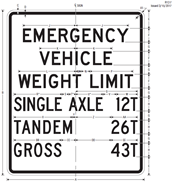The Vermont Agency of Transportation will be installing new signs with weight limits for emergency vehicles on some Municipal-owned bridges throughout the state before the July 30th, 2023 deadline. This deadline applies to municipal-owned bridges, which are subject to the same requirements as our state-owned bridges, as outlined in the Transportation Secretary Memo issued on January 19th, 2022.
Under federal law, the Fixing America's Surface Transportation Act (FAST Act), and in response to a trend of trucks getting larger, some exceeding the weight of trucks that were in use when many bridges were designed, Vermont, along with all other states, is working to meet this Federal Highway Administration (FHWA) requirement by expanding necessary load ratings to include emergency vehicles and posting if required. Load ratings determine the effect that these heavier and larger trucks have on a bridge, the bridge’s capacity to safely handle the load, and whether a posting is needed.
The goal is to ensure that emergency responders are aware of the potential safety concern as it relates to emergency vehicles. VTrans and the State of Vermont understand that this may cause additional burden to some Municipalities. To assist in meeting this requirement, VTrans is performing the necessary load ratings and sign installations. A list of bridges that require posting will be provided to each municipality a minimum of three weeks prior to installing signs, providing bridge owners the opportunity for public notice if they so choose.
With the exception of some bridge signs that will show only a gross weight to match existing posting, all emergency vehicle posting signs on Municipal bridges will show a maximum single axle, maximum tandem, and maximum gross weight in tons that should, based on calculation and being the only vehicle straddling the centerline, cross the bridge.

Vermont statue allows exemptions for construction, maintenance, and emergency response vehicles (https://legislature.vermont.gov/statutes/section/23/013/01399). While fire apparatus and emergency response vehicles may choose to cross a bridge, the posting will identify the risk.
Click here to view a list of State Highway bridges with emergency vehicle postings.
Click here to view a list of Municipal-Town owned bridges that are receiving emergency vehicle postings by July 30th 2023.
Frequently Asked Questions
Why is VTrans posting these weight limits now?
The State of Vermont, including Municipalities, must come into compliance with guidance from the Federal Highway Administration (FHWA) in pursuant with the federal FAST Act of 2015. This is to ensure safety since some older bridges were designed for smaller and lighter vehicles, and emergency vehicles today are larger and heavier.
Will these bridge weight limit postings affect emergency services response times?
Emergency response agencies or service providers may decide to alter routes depending on the weights of their vehicles and the posted weight limits of bridges in their service area. To learn more about a specific area, it is best to contact the local fire department.
The Importance of Bridge Maintenance and Preservation for Long-Term Service Life!
Bridges are a vital component of our transportation system and play a critical role in ensuring the safe and efficient movement of people and goods. Regular maintenance and preservation of bridges is crucial to ensure their longevity and prevent costly repairs or replacements. By following proven and innovative techniques, the Bridge Preservation Program can extend the service life of bridges up to 100 years, which is a significant investment in the future of our transportation infrastructure.\
What are the benefits of bridge maintenance?
Maintaining bridges not only ensures the safety of the public but also helps to avoid load restrictions that may impact the efficient movement of goods and people. Additionally, it can reduce the overall cost of maintaining the transportation system by preventing the need for costly emergency repairs and replacements. Proper maintenance practices can also prevent deterioration and damage to the bridges caused by weather, traffic, and other environmental factors.
What should Bridge Owners do?
Bridge Owners should prioritize the maintenance and preservation of their bridges to ensure they remain safe and reliable for years to come. By working closely with the Bridge Preservation Program and other relevant departments, Bridge Owners can identify cost-effective and timely preservation measures that protect the structural integrity of their bridges and provide long-term benefits for the community.
